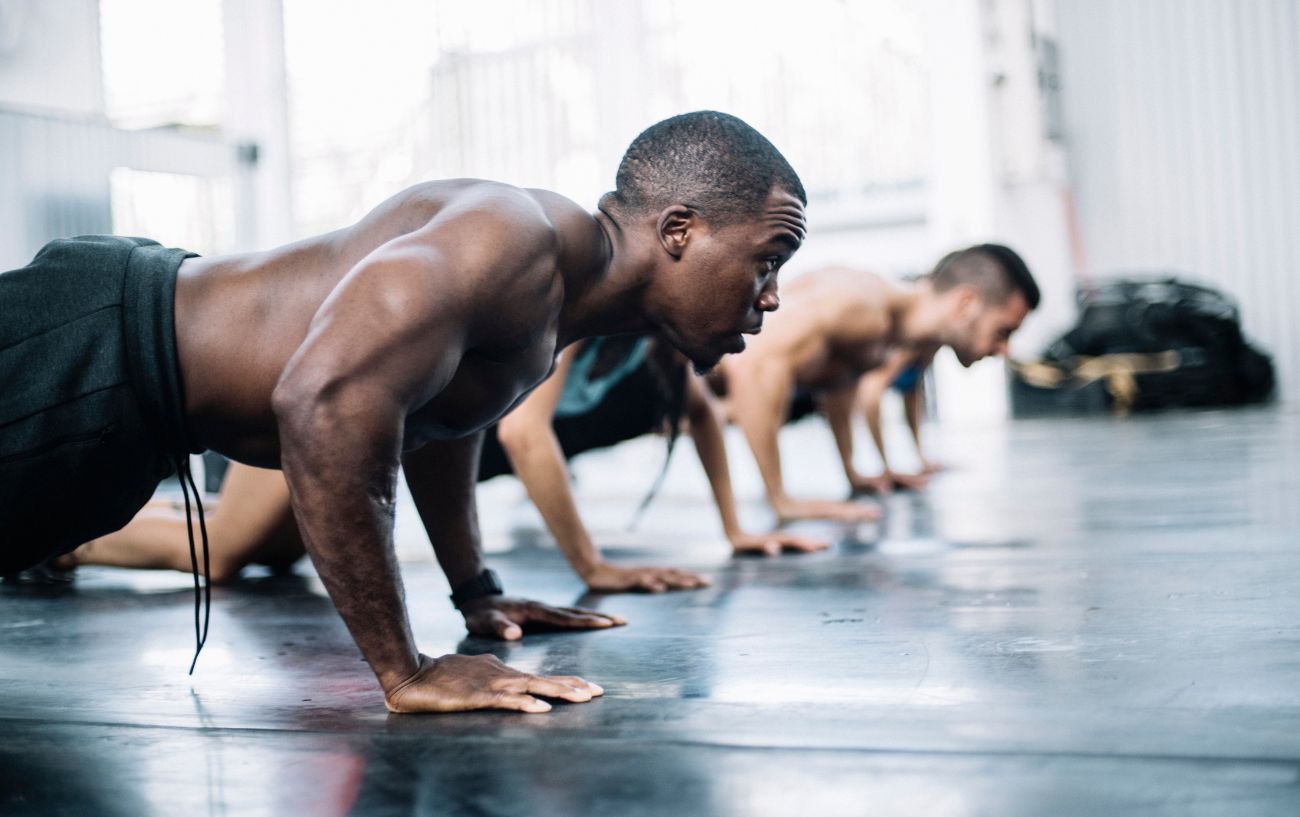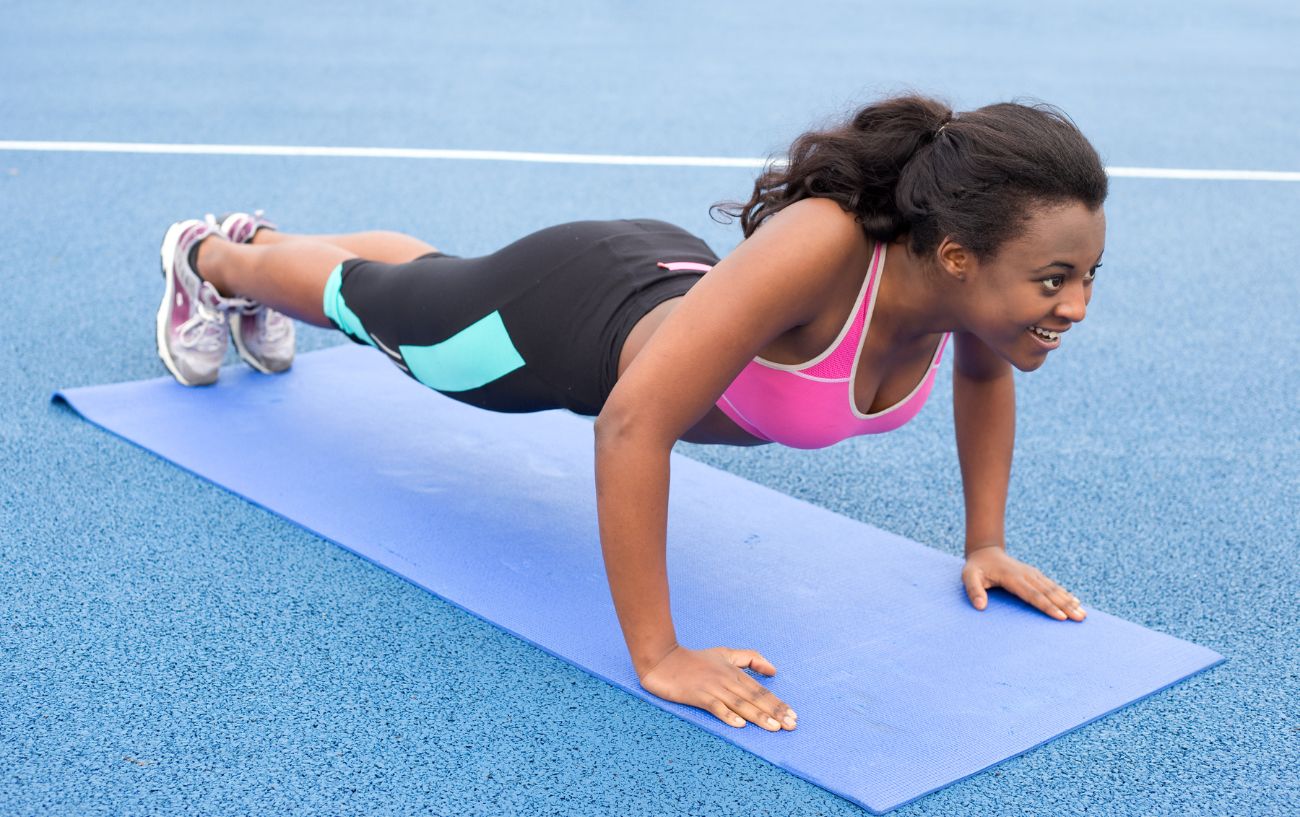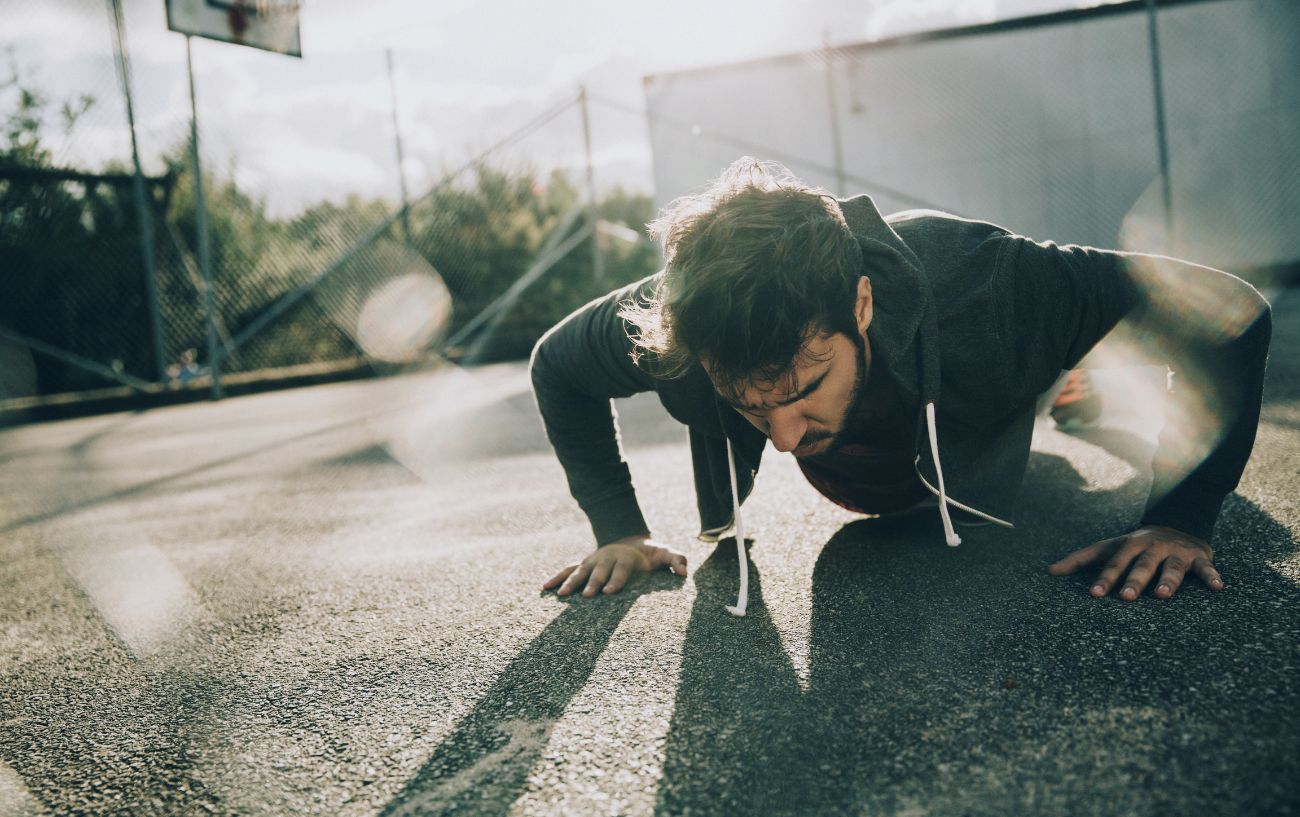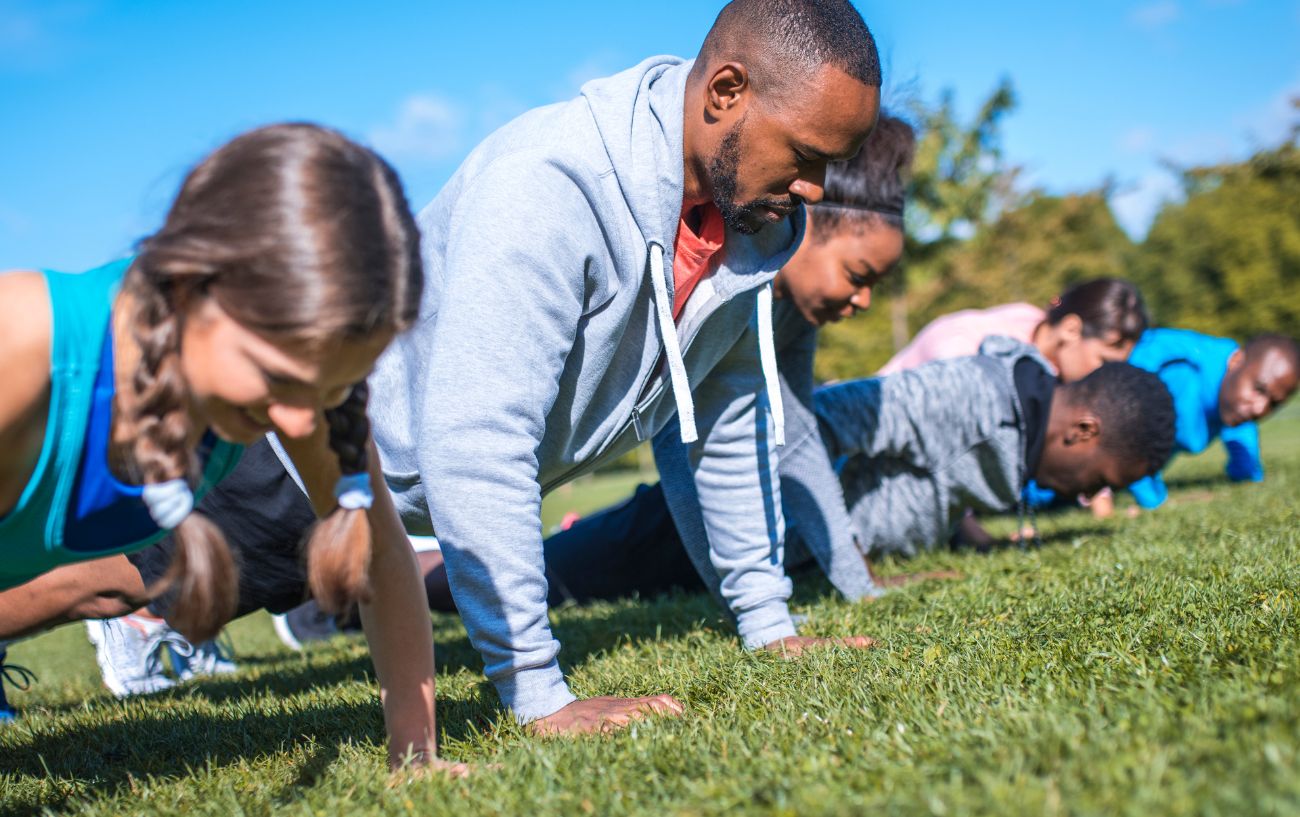Push-ups are a classic bodyweight exercise that every kid learns in PE class or youth sports, and like many of the best exercises, push-ups remain a mainstay (or at least they should!) in the workout routines of adults as well.
Although push-ups can be quite challenging for beginners, there are many benefits of doing push-ups every day, so the payoff is definitely worth the effort.
Moreover, there are lots of ways to regress and progress the push-up based on your fitness level and workout goals.
In this article, we will discuss the benefits of doing push-ups every day, how to do push-ups, and tips for doing push-up workouts.
We will cover:
- What Is a Push-Up?
- 5 Benefits of Doing Push-Ups Every Day
- How to Do a Push-Ups
- Common Mistakes With Push-Up Technique
- 5 Tips for Doing Push-Ups Every Day
Let’s get started!

What Is a Push-Up?
A push-up is a bodyweight exercise, or a calisthenic exercise, that primarily targets the pectoralis major and pectoralis minor muscles in the chest, the triceps in the upper arm, the deltoids and rotator cuff muscles in the shoulders, as well as the core and upper-back muscles.
Basic push-ups are performed with your hands and feet on the ground, with the body in a straight line from the top of the head to the heels.
Keeping your back straight, you bend your elbows to lower your chest to the ground (without touching it), and then you push back up to the starting position.
5 Benefits of Doing Push-Ups Every Day
Mastering a push-up is not just an admirable goal that earns you a rather meaningless badge of honor; rather, there are also many benefits of doing push-ups every day, including the following:

#1: Push-Ups Strengthen Your Muscles
Push-ups are a great upper-body exercise, focusing on the “pushing” muscles.
Push-ups strengthen the triceps in your arms, shoulders (deltoids), chest (pecs), and traps in your back.
Additionally, if you keep your core tight and glutes and quads engaged, push-ups also strengthen your entire core—the superficial and deep abdominal muscles, obliques, glutes, back, and hips.
A strong core is critical for runners and athletes of all sports because the core connects the upper and lower body and provides the foundation, or anchor point, from which your arms and legs can move.
The stronger and more stable that foundation or base of support is, the more efficiently and powerfully you will be able to move your limbs without throwing off your center of mass.
In this way, your core helps coordinate and orchestrate an efficient, safe, and powerful running stride, walking stride, cycling pedal stroke, jumping ability, etc.

#2: Push-Ups Increase Your Heart Rate
Although push-ups are more of a strength training exercise than they are an aerobic exercise, if you perform multiple sets of push-ups with your reps done as rapidly as possible (while still using proper form and technique), push-ups can increase your heart rate and respiration rate, turning the exercise into a cardio workout as well.
#3: Push-Ups Can Decrease Your Risk of Cardiovascular Disease
It is well established that aerobic exercise can reduce the risk of cardiovascular disease and mortality, but there is also evidence to suggest that push-ups can be an effective way to improve heart health as well.
A longitudinal cohort study of 1,104 active subjects found a significant negative association between the participants’ baseline push-up capacity and their incidence of cardiovascular disease over a period of 10 years.
Results revealed that subjects who were able to complete more than 40 push-ups at baseline had a significantly lower risk of cardiovascular disease compared with subjects who completed fewer than 10 push-ups at baseline.
Although this is only indicative of a correlation rather than evidence of direct causation, it’s still certainly some good motivation to continue doing as many push-ups as you can.

#4: Push-Ups Don’t Require Equipment
Push-ups are bodyweight exercises, so you don’t need dumbbells, kettlebells, exercise machines, or even resistance bands to do them.
This makes push-ups a good exercise for people who don’t have access to a gym or who can’t afford a lot of exercise equipment, especially because a lot of upper-body strengthening exercises do require some type of resistance equipment.
#5: Push-Ups Can Be Done Anywhere
Because push-ups don’t require equipment, they can be performed just about anywhere, making push-ups one of the best exercises for at-home workouts, outdoor workouts, or hotel room workouts.
As long as you have floor space slightly longer than your height, you can do push-ups.

How to Do a Push-Up
The key to maximizing the benefits of doing push-ups every day is that you have to use the correct push-up technique.
Unfortunately, it’s common to see beginners as well as experienced gym goers using the improper form when doing push-ups.
This not only compromises the potential benefits of doing push-ups every day, but it also increases the risk of injury.
One important form tip for push-ups is to engage your glutes and quads and draw your belly button up to your spine while keeping a neutral spine and neck for the duration of the exercise.
Squeezing your glutes, quads, and core not only transformed the push-up into more of a total body exercise, but it also helps support your spine to prevent your lower back from sagging and hurting.

Here is how to do a push-up properly:
- Get into the starting position by placing your palms on the floor slightly wider than shoulder-width apart and your toes on the floor behind you. Your elbows should line up directly underneath your shoulder. Your body should be in a straight line from your head to your feet. Make sure your core and glutes are engaged.
- To perform the push-up, bend your elbows and lower your chest to just above the floor and then push through your palms to lift your body back up until your elbows are extended but not fully locked out.
- Be sure to breathe throughout the exercise, and don’t let your hips sag. Your hips should always be in line with your body. Actively push your heels away from you to promote good form.
Common Mistakes With Push-Up Technique
There are a few common errors that people make when performing push-ups:
- Not going deep enough: Our brains try to get out of doing things that are going to be uncomfortable for the body, so it’s a natural inclination to not go deep enough on the push-up. Your elbows should be bent to at least 90 degrees. Bring your chest as close to the ground as possible. The deeper you go, the greater the muscular demand and the more benefits you will get from doing push-ups. Shallow push-ups will do little to strengthen your muscles.
- Going too fast: Performing push-ups vigorously, with one rep after another at a fast cadence, definitely has its benefits from a cardiovascular standpoint. However, many people who try to rush through push-ups too quickly make the aforementioned mistake of not going deep enough. A push-up is a more effective strengthening move if you actually work the muscles through the full range of motion rather than “cheating” by only going down part way.

- Allowing your lower back to sag: It’s critical to keep your back straight without dropping your hips and butt down during the push-up to prevent strain and stress on your lower back.
- Sticking your butt in the air: Again, it’s important to keep your hips in line with your body. Sticking your butt up into the air will reduce the workload on the core and make the push-up less effective.
- Spacing your hands too close or too far: There are benefits to modifying the hand placement for push-ups because you can target different muscle fibers, but unless you are deliberately attempting to do narrow push-ups or wide push-ups, you should place your hands just slightly wider than shoulder-width apart.
5 Tips for Doing Push-Ups Every Day
Here are some push-up tips for beginners:
#1: Modify Your Push-Ups
Don’t be afraid to modify push-ups as you build strength.
You can perform them against a wall or with your hands on a desk or table. Then, progress to your knees before finally performing them from your feet.

#2: Do Push-Ups Every Day
Consistency is key. Doing push-ups every day can help you get stronger and more competent.
#3: Incorporate Push-Up Variations
There are tons of push-up variations, such as narrow push-ups, diamond push-ups, wide push-ups, clapping push-ups, push-up jacks, medicine ball push-ups, push-ups with your feet up on a stability ball, and one-handed push-ups.
Adding different push-up variations into your push-up workouts will not only prevent you from getting tired of the same old exercise but each type of push-up targets different muscle fibers and presents a slightly different stimulus to your muscles.
This will help you develop better functional strength and will prevent your body from adapting and hitting plateaus in your fitness.
#4: Add Resistance
Once you have mastered basic push-ups, you can progress the exercise by wearing a weighted vest or adding a weight plate to your back to increase the resistance.
#5: Try a 30-Day Push-Up Challenge
Need a bit of motivation to do push-ups or a push-up training program to reap the benefits of doing push-ups every day?
Try a 30-day push-up challenge!













